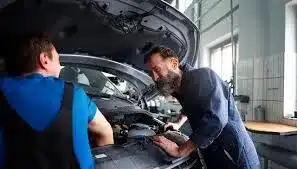Automobiles are an assemblage of systems working cohesively in a complex machine. But they are, like any machine, subject to “wear, faults, breakdowns” . Perhaps the most important of these is the alternator, which is a part of your car’s charging system. The entire electrical system of the car goes down when it doesn’t work. If you suspect that there are some electrical issues, it is vital to understand what electrical problems can manifest.
In this article we’ll cover most common automobile faults and how to properly diagnose them to keep your car safe and reliable on the road.
1. Faulty Alternator:
A faulty alternator is among the most common reasons for sudden car problems. It’s responsible for recharging the battery and powering the electrical components of your vehicle, such as the headlights, dashboard electronics, and infotainment systems .
Symptoms:
- Dim or flickering lights
- Battery dies after minimal usage Dashboard warning light (battery symbol) Burnt smell or whining sound coming from engine bay
Diagnostic Tip:
Measure voltage output with a multimeter. When the engine is running, the alternator should supply 13.5-14.5 volts. If it’s lower, a replacement may be needed. Make sure to consider the actual alternator replacement cost and quality before making a purchase or repair.
2. Engine Misfiring or Running Rough:
A misfire occurs when one or more engine cylinders do not fire correctly. This could lead to rough idle, lack of power, or stalling .
Causes:
- Dirty spark plugs
- Bad ignition coils
- Dirty/Faulty Fuel Injectors
- Leaking vacuums
Diagnostic Tip:
Check for engine error codes using an OBD-II scanner. The mechanic will then be able to determine the cylinder or system where the failure is located.
3. Failed Battery:
Although battery and alternator problems are closely related, the battery itself may sometimes be to blame.
Signs:
- Clicking sound when trying to start the vehicle
- Slow engine start
- Intermittent electrical systems
Diagnostic Tip:
Measure battery voltage using a multimeter; voltage should be approximately 12.6 volts with the engine off. Look for corrosion around the terminals as well.
4. Engine Overheating:
An overheating engine can lead to long-term issues if allowed to continue. This usually happens when there is a malfunction of the cooling system .
Potential Causes:
- Low level of coolant
- Defective radiator or water pump
- Defective thermostat
- Hoses that are leaking
Diagnostic Tip:
Examine the coolant level, leaks, and radiator fan. Another method is to pay attention to the temperature gauge on your dashboard.
5. Brake System Issues:
Brakes are critical for safety. Even small issues can turn into dangerous problems.
Common Signs:
- Brake squeak or grind
- Spongy or soft brake pedal
- Car veers to the left or to the right when braking
Diagnostic Tip:
Check brake pads, discs and fluid level. Low or leaking brake fluid should be remedied promptly. Use a flashlight to verify pad thickness.
6. Transmission Problems:
A bad transmission may result in jerky movement, slipping gears or complete failure of the drivetrain.
Symptoms:
- Delayed engagement of gears
- Smell of burning
- Rough or noisy shifting
Diagnostic Tip:
Inspect transmission fluid level and color. If it smells dark or burnt, you may need a transmission service or replacement.
7. Faulty Sensors:
Modern vehicles are equipped with oxygen sensors, mass airflow sensors, and others to control performance and emissions. When these sensors are impaired, this can lead to drastic behavioral changes of the car.
Warning Signs:
- Malfunction Indicator Light ON
- Low fuel economy
- Poor idle
Diagnostic Tip:
An OBD scanner will assist on finding the defective sensor. The resolution is usually to replace or clean the sensor.
8. Exhaust System Leaks:
A leaking exhaust not only compromises car performance and emissions, but can expose occupants to harmful gases.
Common Indicators:
- Rowdy engine sound
- Decreased acceleration
- Exhaust fumes in the cabin
Diagnostic Tip:
Visually examine the sections of pipe, muffler and joints. A mechanic can do a smoke test to locate concealed leaks.
The Role of Professional Inspection:
DIY checks can be supportive, but accurate diagnostics definitely require expert tools and experience. A service provider that you trust like Unitech Motor can save you time and money and avoid mistakes by partnership. They not only provide those auto parts that are of premium quality but also give diagnostic support so that the installation is done correctly and the function is guaranteed.
Unitech Motor’s parts catalog is very wide and it includes a variety of vehicle makes and models so that one can always easily and confidently source everything from alternators to ignition systems.
Conclusion
It is very important for every car owner to be able to recognize the early symptoms of the car’s system and be aware of the car faults that are most common. If you diagnose and fix the problem quickly, it can stop a car from breaking down in a very expensive manner and besides that, it will also ensure that your car runs smoothly. From an alternator problem to a brake system fault, taking action before the problem starts is the key.
If you decide to find out what the alternator replacement cost is or you would like to buy a new part, being with the professional suppliers like Unitech Motor is a guarantee that you will get the best value and long–term reliability.







